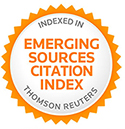Solidaridad de clase y política sexual de las relaciones entre indios/africanos en la literatura trinitaria (Traducción: Fabiola Reyes).
Resumen
La población de Trinidad y Tobago es el reflejo de una historia rica en diversidad étnica. El buen manejo de esta diversidad excepcional ha sido uno de los desafíos cruciales del estado en la postindependencia. Particularmente, las relaciones que han surgido entre dos de los principales grupos étnicos, el indio y el africano, se presentan como el asunto primordial de la política, economía y cultura de Trinidad y Tobago. La solidaridad en la clase trabajadora sigue siendo la proposición teórica fundamental para garantizar la solidaridad entre los grupos indio y africano. La propuesta de este artículo consta de dos partes: se recuperan algunas obras literarias poco conocidas que se añaden al grupo de representaciones de esta filosofía en la ficción, y se analizan las intersecciones de clase y género que definen las relaciones étnicas. Para lograr este último propósito, se establecen diálogos entre clase y etnicidad y entre política y literatura que problematizan tratados acreditados acerca de las relaciones entre indios y africanos en Trinidad.
Palabras clave
Texto completo:
PDFReferencias
Ack Ack (Samuel Selvon) (1948). ‘Obean Man’ In: Guardian Weekly
Magazine. Trinidad: The Guardian. February 29th
Brereton, Bridget. (1981). A History of Modern Trinidad 1783-1962.
London: Heinemann.
Caballo, Louis. (1948). ‘Boodram’, Guardian Weekly Magazine. Trinidad:
The Guardian. August 15th
Cross, Malcolm. (1978). ‘Colonialism and Ethnicity: a theory and
comparative case study’ in Ethnic and Racial Studies, 1 (1), 37-39.
Davis, Wayne. 1975. ‘First Meeting With Salina’. In: New Voices. Trinidad:
The New Voices, 3 (6), 23.
Henderson, Thelma. 1988. ‘The Contemporary Women’s Movement in
Trinidad and Tobago’, in Mohammed, P. and Shepherd, C eds, 1988,
Gender in Caribbean Development. Trinidad: Women and
Development Studies Project, 367-376.
Jagan, Cheddi. (1967). The West on Trial: My Fight for Guyana’s
Freedom. New York: International Publishers.
Jagessar, Ramdath. (1969). The Indian Iceberg, Tapia. Trinidad: Tapia.
November 16th
____________(1974). “Fight Racism and Negro Chauvinism”,
Embryo, 6 (5), 13,16.
Kwesi, Lansana. (1975). ‘My brother is an indian’, in Kwesi, Lansana
(1975), Poems of Rebellion. Trinidad: Lansana Kwesi, 9.
Ladoo, Harold Sonny. (1972). No Pain Like This Body. London:
Heinemann.
____________.(1974). Yesterdays. Toronto: Anansi.
La Guerre, John. (1985). Calcutta to Caroni: The East Indians of Trinidad.
Trinidad: UWI Extra Mural Studies Unit.
Lamming, George (1958). Of Age and Innocence. London: Allison and
Busby.
Maharaj, Clem (1992). The Dispossessed. London: Heinemann.
Malik (1971). Black Up. Trinidad: The Free Press, 36-39.
Mohammed, Patricia. (1988). “The ‘Creolization’ of Indian Women in
Trinidad” in Ryan, S. (1988) Trinidad and Tobago: The
Independence Experience 1962-1987. Trinidad: UWI Press, 381-
Mootoo, Shani. 1996. Cereus Blooms at Night. London: Granta Books.
Muniram, Hemraj. 1974. ‘I am coolie, you are black…’ in Muniram, H.
(1974), For the Fighting Front: an anthology of revolutionary
poems. Guyana: PYO, 15.
Nasta, Sushila (1988). Critical Perspectives on Sam Selvon. Washington
D.C.: Three Continents Press.
Patrick, Nesta. 1988. “My Views on Women’s Involvement in
Organizations in Trinidad and Tobago and the Caribbean” in
Mohammed, P. and Shepherd, C. (1988) Gender in Caribbean
Development. Trinidad: Women and Development Studies Project,
-366.
Rajack-Talley, Theresa A. (1999). “‘Burying the Myth’: Indian Women in
the Sugar Cane Industry in Trinidad”, in Kanhai, R. (1999), Matikor:
The Politics of Identity for Indo-Caribbean Women. Trinidad: UWI
Extra Mural Studies Unit, 181-193.
Samaroo, Brinsley. (1985). ‘Politics and Afro-Indian Relations in Trinidad’
in La Guerre, J. (1972), Calcutta to Caroni: The East Indians
of Trinidad. Trinidad: UWI Extra Mural Studies Unit, 77-92.
Scott, Lawrence. (1998). Aelred’s Sin. London: Allison and Busby.
Selvon, Samuel. (1952). A Brighter Sun. Trinidad and Jamaica: Longman.
____________.(1956). Lonely Londoners. London: Allan Wingate.
____________. (1957). Ways of Sunlight. London: MacGibbon and Kee.
____________.(1958). Turn Again Tiger. London: Heinemann.
____________.(1970). The Plains of Caroni. London: MacGibbon and
Kee.
____________.(1979). “Three Into One Can’t Go: East Indian,
Trinidadian, Westindian”, in Dabydeen, D. and Samaroo, B. (1987),
India in the Caribbean. London: Hansib and University of Warwick.
Shepherd, Verene. (1988). “Indians and Blacks in Jamaica in the Nineteenth
and Early Twentieth Centuries: A Micro-Study of the Foundation of
Racial Antagonism”. In: After the Crossing Immigrants and
Minorities, 7 (1), 95-109.
Singh, N. (1973). ‘Lil Sister’, Themes IV, 78.
Wiltshire-Brodber, Rosina (1988). “Gender, Race and Class in the
Caribbean” in Mohammed, P. and Shepherd, C (1988), Gender in
Caribbean Development. Trinidad: Women and Development Studies
Project, 144-157.
Wood, Donald. (1968). Trinidad in Transition the Years After Slavery.
London: Oxford University Press.
Enlaces refback
- No hay ningún enlace refback.
Depósito Legal: pp. 95-0020 | e-Depósito Legal: ME2018000066
ISSN: 1315-9453 | e-ISSN: 2610-7902
DOI: http://doi.org/10.53766/CONTEX
| La revista se encuentra actualmente incluida en: | ||||
 |  |  |  | |
 |  |  | ||
 |
| |||
![]()
Todos los documentos publicados en esta revista se distribuyen bajo una
Licencia Creative Commons Atribución -No Comercial- Compartir Igual 4.0 Internacional.
Por lo que el envío, procesamiento y publicación de artículos en la revista es totalmente gratuito.



